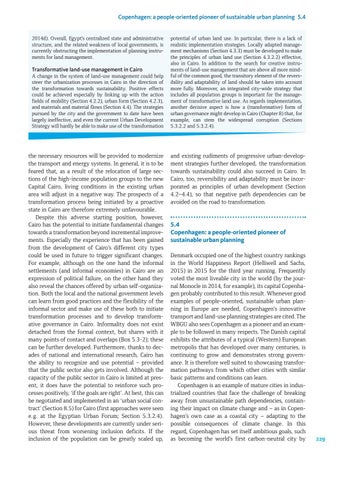Copenhagen: a people-oriented pioneer of sustainable urban planning 5.4
2014d). Overall, Egypt’s centralized state and administrative structure, and the related weakness of local governments, is currently obstructing the implementation of planning instruments for land management.
Transformative land-use management in Cairo A change in the system of land-use management could help steer the urbanization processes in Cairo in the direction of the transformation towards sustainability. Positive effects could be achieved especially by linking up with the action fields of mobility (Section 4.2.2), urban form (Section 4.2.3), and materials and material flows (Section 4.4). The strategies pursued by the city and the government to date have been largely ineffective, and even the current Urban Development Strategy will hardly be able to make use of the transformation
the necessary resources will be provided to modernize the transport and energy systems. In general, it is to be feared that, as a result of the relocation of large sections of the high-income population groups to the new Capital Cairo, living conditions in the existing urban area will adjust in a negative way. The prospects of a transformation process being initiated by a proactive state in Cairo are therefore extremely unfavourable. Despite this adverse starting position, however, Cairo has the potential to initiate fundamental changes towards a transformation beyond incremental improvements. Especially the experience that has been gained from the development of Cairo’s different city types could be used in future to trigger significant changes. For example, although on the one hand the informal settlements (and informal economies) in Cairo are an expression of political failure, on the other hand they also reveal the chances offered by urban self-organization. Both the local and the national government levels can learn from good practices and the flexibility of the informal sector and make use of these both to initiate transformation processes and to develop transformative governance in Cairo. Informality does not exist detached from the formal context, but shares with it many points of contact and overlaps (Box 5.3-2); these can be further developed. Furthermore, thanks to decades of national and international research, Cairo has the ability to recognize and use potential – provided that the public sector also gets involved. Although the capacity of the public sector in Cairo is limited at present, it does have the potential to reinforce such processes positively, ‘if the goals are right’. At best, this can be negotiated and implemented in an ‘urban social contract’ (Section 8.5) for Cairo (first approaches were seen e. g. at the Egyptian Urban Forum; Section 5.3.2.4). However, these developments are currently under serious threat from worsening inclusion deficits. If the inclusion of the population can be greatly scaled up,
potential of urban land use. In particular, there is a lack of realistic implementation strategies. Locally adapted management mechanisms (Section 4.3.3) must be developed to make the principles of urban land use (Section 4.3.2.2) effective, also in Cairo. In addition to the search for creative instruments of land-use management that are above all more mindful of the common good, the transitory element of the reversibility and adaptability of land should be taken into account more fully. Moreover, an integrated city-wide strategy that includes all population groups is important for the management of transformative land use. As regards implementation, another decisive aspect is how a (transformative) form of urban governance might develop in Cairo (Chapter 8) that, for example, can stem the widespread corruption (Sections 5.3.2.2 and 5.3.2.4).
and existing rudiments of progressive urban-development strategies further developed, the transformation towards sustainability could also succeed in Cairo. In Cairo, too, reversibility and adaptability must be incorporated as principles of urban development (Section 4.2–4.4), so that negative path dependencies can be avoided on the road to transformation.
5.4 Copenhagen: a people-oriented pioneer of sustainable urban planning Denmark occupied one of the highest country rankings in the World Happiness Report (Helliwell and Sachs, 2015) in 2015 for the third year running. Frequently voted the most liveable city in the world (by the journal Monocle in 2014, for example), its capital Copenhagen probably contributed to this result. Whenever good examples of people-oriented, sustainable urban planning in Europe are needed, Copenhagen’s innovative transport and land-use planning strategies are cited. The WBGU also sees Copenhagen as a pioneer and an example to be followed in many respects. The Danish capital exhibits the attributes of a typical (Western) European metropolis that has developed over many centuries, is continuing to grow and demonstrates strong governance. It is therefore well suited to showcasing transformation pathways from which other cities with similar basic patterns and conditions can learn. Copenhagen is an example of mature cities in industrialized countries that face the challenge of breaking away from unsustainable path dependencies, containing their impact on climate change and – as in Copenhagen’s own case as a coastal city – adapting to the possible consequences of climate change. In this regard, Copenhagen has set itself ambitious goals, such as becoming the world’s first carbon-neutral city by
229
